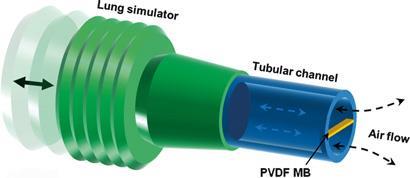Tiny piezoelectric polymer belts produce electricity from respiration
US scientists have made a device that converts air flow from human breath into electricity. The device could serve as a power source for implantable biomedical devices, removing the need for systems with batteries that need replacing in the operating theatre.
’We’ve been working on harvesting nano- and micro-scale mechanical energy from human activities for several years, for powering bioimplantable devices and even personal electronics,’ explains Xudong Wang, who led the research at the University of Wisconsin-Madison.
Respiration could be an important energy source from the human body, but the air flow rate is low (typically 2m/s) and it fluctuates. Scientists have been able to harvest energy from low speed air flow devices at the centimetre scale and above. But previous devices, such as windmills and inductive wind belts, need wind speeds of over 2m/s to operate. So, a much smaller device is needed to harvest energy from respiration. It also needs to be flexible enough to be placed in the body and tough enough to avoid fatigue failure during long-term use.

To achieve these goals, Xudong’s team designed a micrometre-sized polyvinylidene fluoride (PVDF) belt to harvest the energy. They found that to work under a low speed air flow, the PVDF belt needed to be thin enough to be driven into a resonant oscillation (a deformation that generates an electric current). The major challenge, says Wang, was maintaining the strength of the PVDF while getting it to the correct thickness. To overcome this challenge, the team used an ion etching technique to reduce the belt’s thickness.
’Preparing thin PVDF films to harvest energy from weak respiration is an important technology,’ says Masao Kaneko, an expert in functional polymers for energy conversion at The Institute of Biophotochemonics, Japan. ’The team should now attempt to drive a real device by the energy accumulated from respiration.’
Wang says his next step is to improve the energy harvesting efficiency and explore more designs for harvesting other types of mechanical energy from the environment or biological systems.
Carl Saxton
Link to journal article
PVDF microbelts for harvesting energy from respirationChengliang Sun, Jian Shi, Dylan J. Bayerl and Xudong Wang,?Energy Environ. Sci., 2011, 4, 4508DOI:10.1039/c1ee02241e






No comments yet